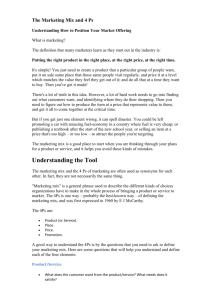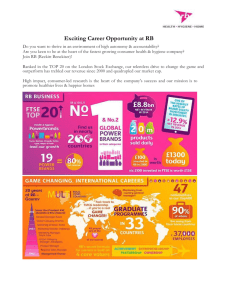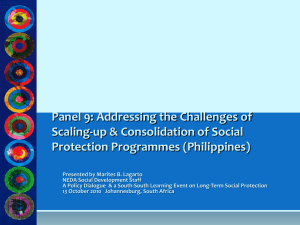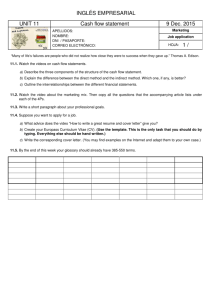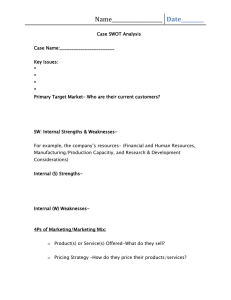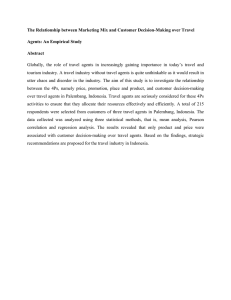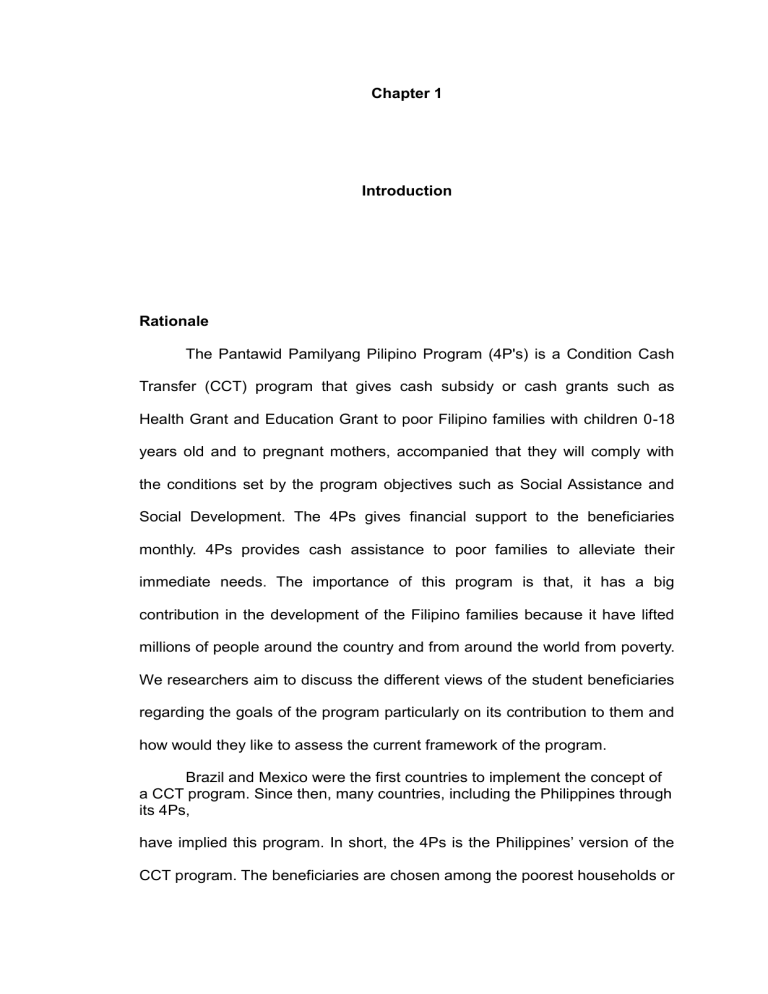
Chapter 1 Introduction Rationale The Pantawid Pamilyang Pilipino Program (4P's) is a Condition Cash Transfer (CCT) program that gives cash subsidy or cash grants such as Health Grant and Education Grant to poor Filipino families with children 0-18 years old and to pregnant mothers, accompanied that they will comply with the conditions set by the program objectives such as Social Assistance and Social Development. The 4Ps gives financial support to the beneficiaries monthly. 4Ps provides cash assistance to poor families to alleviate their immediate needs. The importance of this program is that, it has a big contribution in the development of the Filipino families because it have lifted millions of people around the country and from around the world from poverty. We researchers aim to discuss the different views of the student beneficiaries regarding the goals of the program particularly on its contribution to them and how would they like to assess the current framework of the program. Brazil and Mexico were the first countries to implement the concept of a CCT program. Since then, many countries, including the Philippines through its 4Ps, have implied this program. In short, the 4Ps is the Philippines’ version of the CCT program. The beneficiaries are chosen among the poorest households or families through the use of Targeting System. The households are then assessed according to whether they do or do not suitable to receive the benefits of the program. These monetary grants that the beneficiaries receives are used for health and nutrition purposes and as well as on education purposes. As stated by the World Bank staff, Pantawid has become the third largest CCT program globally next only to Brazil and Mexico. The 4Ps is by far the largest poverty reduction and social development program the Philippine government has ever implemented. In this study, we researchers will determine the contribution and the effectiveness of the 4P's program in helping the parents particularly the Grade 11 students of Maragusan National High School in their financial problems. To the government, the result of this study is important for it provides them the knowledge on how to plan effectively to meet the goal of providing assistance to the poor and to the poorest who really needs their primary help and financial assistance. To the parents, this study will help them to work harder, make them tougher in what challenges they might face and this will help them attain their responsibilities through the help of the government and make it as their inspiration. It will also help them realize that significance of this program. In the same way, this study needs to be conducted for we aim to let the 4P's beneficiaries particularly the Grade 11 students beneficiaries know how important and how big this CCT program will contribute to them. The findings of this study will encourage them to give more time to study and will inspire them to finish schooling. We researchers has browsed a lot of researches in the locale setting and found out that no one is conducting this study that is why we choose to conducted this study thus for the sake of the beneficiaries. We researchers have browse a lot of research in locale settings and found out that no one is conducting this particular topic in their study, thus we decided to create our research title as 4Ps: The contribution of 4Ps in the financial problems of the Grade 11 students of Maragusan National High School. The contribution of 4Ps is really essential for it really helps on the financial problems of the students and also it aids the continuation of its contribution to all. Therefore, the performance of the students upon complying their financial problems are at stake. Research Objectives The primary objective of this study is to measure the contribution of 4Ps in the financial problems of the Grade 11 students. Specifically, this study aimed to answer the following problems: 1. What is the extent of 4Ps in terms of: a. Access to Education b. Health Services 2. What is the level of contribution of 4Ps in the financial problems of the Grade 11 students in therms of: a. Health b. Education c. Financial management 3. What is the significant relationship between 4Ps and its contribution in the financial problems of Grade 11 students. 4. Which domain of 4Ps that significantly influence its contribution in the financial problems of Grade 11 students. Hypotheses The following hypotheses were tested at 0.05 level of significance. 1. There is no significant relationship between 4Ps to the financial problems of the Grade 11 students. 2. There is no domain in 4Ps that significantly influence its contribution in the financial problems of Grade 11 students. Review of Related Literature In this part are the literature and studies in line with the present study. This will provide a ground for better understanding about the variables being used. Theories, principles and concept excerpt from different authors relevant in this study are discussed in this section to give reliable sources to elaborate the different variables under scrutiny. On 4PS 4p's is a social program on Philippines that entails monetary and nonmonetary transfer to the poor or poorest families that have school-age children on the condition that they meets certain terms that are aimed at improving their capacities: they improve their health. As stated by Cecechini (2012), Nutrition and Education are the target of the especially to the poor families with children 0-14 years old to improve health, nutrition, and the educational cash transfer. This is to support extremely poor families to respond to their immediate needs, and by investing the heath and educational of the poor students, to fulfill it's commitment to the Millenium Development Goals (MDGS) specifically in eradicating extreme poverty and hunger, in achieving universal primary education (Albert, 2014). As stated by Ory et al. (2010), Pantawid Pamilyang Pilipino Program(4ps) is a human development session assessed by the government CCT program. Pantawid Pamilyang Pilipino Program Objectives is to provide cash grants to the beneficiaries provided that they comply with the set of conditions by the program. The Pantawid Pamilya Program provides the poorest of the Filipino children through access to education and health services and giving the families the opportunities and inventions that can complement the investment made to them. The 4Ps aims to assess social assistance, giving monetary support to extremely poor families to respond to their immediate need, and also they give health check-ups for pregnant mothers and children deworming and family development sessions. 4Ps also helps to fulfill aspects of poverty and hunger, achieving universal primary education, promoting gender equality, reducing child morality and improving maternal health care (Albert, 2014). Meanwhile, as mentioned above in the introduction of this study, 4Ps is the Philippines’ version of the Condition Cash Transfer (CCT) program. It is a program concept that gives cash subsidy to poor families in the world. Also, Conditional Cash Transfer (CCT) is adopted in some countries such as Brazil, Columbia and Mexico. The Philippine inactively adopted locally the CCT. The program was engaged to lessen poverty in the country. The program would help the poor family to fill their needs. It also provides the financial aid of the poor families in a certain area (Tahilog et.al, 2017). As stated by Somera (2010), A CCT Program is a social contract whereas it provides financial resources to a family in exchange of family’s fulfillment in task that are given to them like sending their children to school in ensuring it’s attendance, regular visits to baranggay or community health centers, also they are obliged to participate in government sponsored feeding program. As mentioned by Rubio (2005), the CCT program addresses both future poverty by fostering human capital accumulation among the young as a means of breaking the Intergenerational Transmission of Poverty and current poverty by providing income support for consumption in the shott run. The goal of this program is to prevent Intergenerational Transference of Poverty and helps to break the infinite cycle of poverty by providing the children a suitable education to help them develop their capacities for a better future (Bloom, 2008). Accordingly, The National Household Targeting System for Poverty Reduction (NHTSPR) is the process used by the government that identifies who and where the poor families are are in the country. The 4P's operates in all the 17 regions in the Philippines, covering 79 provinces, 143 cities, and 1,484 municipalities. Beneficiaries are selected through the National Household Targeting System for Poverty Reduction (NHTS-PR), which identifies who and where the poor are in the country. As of August 26, 2015, there are 4,353,597 active household beneficiaries, of which 570,056 are indigenous households and 217,359 have at least one PWD. The program also covers 10,235,658 schoolchildren aged 0 to 18, from the total registered with an average of two to three children per household (Albert, 2014). Meanwhile, Poverty Targeting is the decision making process used by the government and agencies on selecting and choosing the deserving family recipient for the program after the National Household Targeting System for Poverty Reduction (NHTSPR) process. As stated by Somera (2010), the target of 4P’s are the poor households with children that aged 0-18 years old and who care located in poor areas. Also, The Family Development Session (FDS) was implemented by the Department of Social Welfare and Development. They are encouraging the Local Government Unit (LGU) to make it a policy. DSWD assured that the LGU will going to respond positively in implementing the FDS program. The directors of DSWD-7, Ma. Evelyn Macapobre was presenting the FDS program to be implemented as a policy. “We encourage the LGU, to pass a local policy in strengthening FDS in their locality” said Macapobre. She also state that, through the local policy, they could able to determine the various subject matter experts that they could make it more understandable to differentiate the certain session. Example, they could utilize and manage to discuss about the health nutrition by a right nutritionist, dietitian and if it is about the peace and order the police would take change to give discussion to the beneficiaries to aim new skills that will improve their self and additional for that, FDS will impart the beneficiaries to possess knowledge on parental role and responsibilities on issues such as health, nutrition, education, protection and the psychological needs of their children. The program also advocates the importance to have a positive family values that is worthy of emulation, strengthening marital relationship and encouraging each individual to actively participate in their community. They also have a monthly discussion session; the program also requires couples who are beneficiaries to attend monthly sessions for them to understand more the importance of having and implementing the program. Discussing the significance of family planning and responsible parenthood and to expose their awareness in various issues within the community (Freeman, 2017). On Contribution of 4Ps in the Financial Problems of the students This study aims to know the contribution of 4Ps in terms of financial problem to the students and to the poor households. The program was contributed greatly to school performance and awareness of the students. Through this program, students will be able to pay their school contribution and buy their school supplies. The program provides cash grant to poor families to help their needs immediate needs. At the same time, it aims to break the “intergenerational poverty” by investing a human capital. The latter is achieving by improving conditions in exchange for the cash assistance the program gives to the beneficiaries (Cuesra, 2014; Tutor, 2014; Onishi, 2013). The Pantawid Pamilya grants are paid directly though their own Land Bank of the Philippines (LBP) accounts. Grants are remitted through the beneficiary households' LBP accounts or they withdrawn from Automated Teller Machine (ATM) or through one-one-one counter transactions. The responsibility of managing the cash grants to the mother. Experience in CCT program shows that women made relatively better use of grant money by using it to purchase food, or other necessities. If the mother is absent or no longer part of the household, the 4Ps also allows another member of the household to be the grantees in the orders of the father, grandparents or guardian with the subject of verification, endorsement and monitoring by the Municipal Social Worker. Grants were paid quarterly during 2008-2010, but DSWD changed to bimonthly payments starting the first quarter of 2011 (Philippine Social Protection Note, 2011; Mina, 2011; Reyes, 2011). On Education Component, A total of 1,768 students from the Pantawid Pamilyang Pilipino Program (4PS) under the Expanded Students Grants-InAid Program for Poverty Alleviation ( ESGP- PA) recently finished college. Beneficiaries of the Program are required to take up courses that are among those identified with the National Development Plans manpower demands (Guardo, 2018). In the same way, this program help the students to finish their studies, and many of the students graduated with their degrees. These students graduated from the five partner- SUCS in Central Visayas. These are Cebu Pechnological University (CTU), with 662 graduates; followed by Bohol Island State University University(CNU), with (BISU), 306 with 619 graduates, graduates, Negros Cebu Normal Oriental State University(NORSU) with 112 graduates and Siquijor State College(SSC), with 70 graduates. Out of the 1,768 graduates, 200 received, Latin Honors and Leadership Awards. Therefore through the program many of the students graduated (Bloom, 2016). Meanwhile, the study of the Philippines Institute of Development Studies (PIDS) shows that children who finishes High School get better ways up to 40% higher than an elementary graduate. Over 10.8 million children gets good benefits from the program. On April 2018, approximately 200,000 beneficiaries were graduated from Senior High School which also means that they are now also graduated from the program (Pinol, 2017). Accordingly, 4P's will give PHP 3,000 per child for one school year which is 10 months to be exact to meet his/her educational expenses. Each family-beneficiary receives cash for up to a maximum of three children under the educational grant. At the same time, Social Assistance gives financial support to surpassingly poor families to sustain their immediate and primary needs. Every child in elementary school they receive Php. 300.00, while those secondary students receive Php. 500.00 for 100 months. It is only limited to 3 children per household. This education conditionalities and transfer are substantially larger to the health care payouts (DSWD, 2017). As stated by Cento Fante (2015) , 4p's Program leads to an increase in the school participation rate 3.0 percentage points among children aged 6-14 conditional cash transfer program is the mother program where the Pantawid Pamilyang Pilipino Program of the Philippines Government was derived. In this program, the less fortunate were given the privilege to enjoy cash assistance from the government. Similarly, Social Development resolves the Intergenerational poverty Cycle by infusing in the health and nutrition of poor children through programs such as deworming of schoolchildren aged 6 to 14 years old, enrollment of children in daycare, elementary and secondary schools and family development sessions. Under the health component, the 4P's will give PHP 6,000 annually which is PHP 500 per month to each family-benefiary for their health and nutrition expenses (Orbeta, 2013; Velarde and Fernanadez, 2011; Santiago, 2010). Meanwhile, The 4P’s implementation has helped learner’s child labor incidence and child abuse. In some cases there are two interrelated mechanism to fight child labor. First, through cash subsidy, it has helped to reduce schoolings direct case. 85% of the school days per month of the children are the exchange of cash subsidy (Gee, 2010). Meanwhile on Human Rights, While 4Ps design aligns with the overall start obligation to ensure the progressive realization of citizen's human rights, this does not mean that human rights practice is meaningfully mainstream in this program. Studies reviewed for this series have not surfaced any initiatives to use 4Ps as an opportunity to increase the awareness of the beneficiaries on their basic rights—clearly a missed opportunity. Mainstreaming human rights in the program may contribute to the empowerment of the beneficiaries, who will be aware of their rights and responsibilities as citizens. Opportunities for rights claiming of the beneficiaries can also be improved, such as the maximization of grievance mechanisms and creating more spaces for the active participation of the beneficiaries beyond the traditional program operations. A holistic rights-based approach to governance will show that the 4Ps is only part of what should be a whole gamut of development programs available. Aside from the education and health needs of the poor families, their immediate and long term needs also ought to be supported adequately. Key here is ensuring that the government development agenda harmonizes all existing interventions so that in efficiencies are minimize and positive impacts reach those who need them the most. Admittedly, popularizing human rights within the 4Ps program is an enormous endeavor, particularly in the need to capacitate its implementors. Still, simple changes can be put in place as in changing the common term beneficiaries to partners in order to emphasize the roles of the member-households beyond the set conditionalities. The DSWD will need the support of the academe and civil societies in improving the 4Ps according to human rights standard (Linco, 2017; philrightorg, 2017). The goal of 4Ps is to achieve improvements in human capital. It seems to have great potential in enhancing educational attainment and improving nutrition and health outcome base on the experience of other countries who had also implemented the CCT or the Conditional Cash Transfer (Tabungu, 2012). As a result, the Pantawid Pamilyang Pilipino Program (4Ps) has greatly contributed to the school performance and has raised awareness to the school personnel and recipients such as identifying its strengths, weaknesses, opportunities and threats (Dela Torre, 2012). Students and pupils got a very satisfactory benefit from the assistance give by the program in terms financial problems. Through this program students will be able to pay their contributions in school, and they are able to buy those things that can be used in school (Montella, 2015). The sign of success of the implementation of the Pantawid Pamilya and its targeting system, combined with the government to address the high degree of vulnerability among Filipinos since the program launched on 2008 that doubled from 2010 t 2011 has grown by more than 10 folds. The impact evaluations of this program show that CCTs can be a good instrument to address present and future poverty issues of the country (Official Gazette, 2016). Conceptual Framework This part intend to establish a conceptual framework and to introduce our independent and dependent variables with its indicators as shown in figure 1. The Pantawid Pamilyang Pilipino Program (4Ps) provides the cash grants to the beneficiaries provide that they comply with the set of conditions required by the program. The 4Ps has dual objectives as the flagship poverty alleviation program of Independent Variable 4P’s 1. Pantawid Pamilyang Pilipino Program Objectives 2. Conditional Cash Transfer (CCT) 3. National Household Targeting System of Poverty Reduction (NHTSPR) 4. Family Development Session (FDS) Dependent variable Contribution of 4P’s in the Financial Problems of grade 11 students 1. Education Component 2. Social Assistance 3. Social Development 4. Human Rights Figure 1. The Conceptual Paradigm of the Study the Aquino administration: giving monetary support to the poor households to respond their needs. The contributions of 4P’s are the social assistance and social development. It breaks the intergenerational poverty cycle by investing the education, health and nutrition conditions. It is require through periodic checkups, growth monitoring and vaccination for children aged 0-5 years of age; deforming of schoolchildren 6-14 years old; prenatal care for pregnant woman; and attendance of parents in family development sessions; and also the enrollment of children in daycare, elementary and secondary schools (De Jesus, 2011. Accordingly, The 4Ps also helps the Philippine government in fulfilling its commitment to the Millennium Development Goals (MDGs) mainly in eradicating poverty and hunger, achieving universal primary education, promoting gender equality, reducing child morality and mostly in improving maternal health care (Albert, 2014; Attanasio et. Al, 2010; Glewne, 2010). This study aims to know the contribution of 4Ps in terms of financial problem to the students and to the poor households. Th program was contributed greatly to school performance and awareness of the students. Through this program, students will be able to pay their school contribution and buy their school supplies. The variables of the study are the 4Ps as independent variable and contribution of 4Ps in the financial problems of Grade 11 students as the dependent variable. 4Ps has the following indicators: Pantawid Pamilyang Pilipino Program Objectives, Conditional Cash Transfer (CCT), National Household Targeting System for Poverty Reduction (NHTSPR) and the Family Development Session (FDS). While the contribution of 4Ps in the financial problems of Grade 11 students has the following indicators: Social Assistance, Social Development, Education component and Human Rights. Pantawid Pamilyang Pilipino Program Objectives are objectives which provide cash grants to the beneficiaries provided that they comply with the set of conditions by the program (Albert, 2014). Conditional Cash Transfer (CCT), is a program concept that gives cash subsidy to poor families in the world. The program was engaged to lessen poverty in the country. The program would help the poor family to fill their needs. It also provides the financial aid of the poor families in a certain area (Tahilog et.al,2017). National Household Targeting System for Poverty Reduction (NHTSPR) is the process used by the government that identifies who and where the poor families are are in the country. Beneficiaries are selected through the National Household Targeting System for Poverty Reduction (NHTS-PR), which identifies who and where the poor are in the country (Albert, 2014). Family Development Session (FDS), The Family Development Session (FDS) was implemented by the Department of Social Welfare and Development. It is for encouraging the Local Government Unit (LGU) to make it a policy. For this reason, they could able to determine the various subject matter experts that they could make it more understandable to differentiate the certain session (Freeman, 2017). Education Component, in which the beneficiaries of the program are required to take up courses that are among those identified with the National Development Plans manpower demands. In the same way, this program help the students to finish their studies, and many of the students graduated with their degrees (Guardo, 2018). Social Assistance, in which it gives financial support to surpassingly poor families to sustain their immediate and primary, needs (DSWD, 2017). Social Development, in which this program resolves the Intergenerational poverty Cycle by infusing in the health and nutrition of poor children through programs (Orbeta, 2013; Velarde and Fernanadez, 2011; Santiago, 2010). Human Rights, In which mainstreaming human rights in the program may contribute to the empowerment of the beneficiaries, who will be aware of their rights and responsibilities as citizens (Linco, 2017; philrightorg, 2017). Significance of the study One of the beneficiaries of this study is the government specifically the Philippine Health Insurance Corp. (Phil-Health) and the Department of Social Welfare and Development (DSWD). For which the result of this study is important for it provides them the knowledge on how to meet the goal of providing assistance to the poor and to the poorest whom really needs their primary and financial help. They will indicate Social Development by investing in capability building. They will be able to break Intergenerational Poverty Cycle. The Partnership of the Philippine Health Insurance Corp. and the Department of Social Welfare and Development is covering more of the country's poorest families. They agreed to provide health care for the poor. DSWD said that there are more than 4.4 million 4Ps beneficiaries covered by Phil-Health. The partnership has strengthened the government's commitment to give poor families access to medical and health services as stated by Corazon Soliman, the DSWD secretary. Another beneficiary of this study is the Parents. This study will motivate them to work harder, make them tougher whatever challenges they might face and encounter. This will also help them attain their responsibilities through the help of the government and make it as their inspiration. Each family-beneficiary will be receiving one sack of rice, PHP 500.00 per month and they will also get benefits from the programs that the 4Ps have such as Health check-ups for pregnant mothers and Health check-ups for their children. The assigned Parent-Leaders also from every “baranggay” will be receiving PHP 3,000.00 as their annual allowance. This will serve as their compensation for performing their duties in monitoring the lifestyle od their 4Ps co-beneficiaries. And lastly the Students, for the findings of this study will encourage them to give more time to study and will inspire them to finish schooling. The 4Ps will be helping them to provide financial problems. Through this program, they will be able to pay their school fees, buy their projects and help them pay the cost of their uniforms and requirements. This study will help them express their feelings, emotions, opinions and perspective. This will help to be able or them speak up and be heard by the government. Definition of Terms This are the important terms that are being define operationally in the study. Pantawid Pamilyang Pilipino Program. As indicated in this study, it is the Conditional Cash Transfer of the Philippines. Conditional Cash Transfer. As indicated in this study, it is a program concept that gives cash subsidy to poor families in the world. Beneficiaries. As indicated in this study, it is the people whom will be receiving cash subsidy from the program. World Bank. As indicated in this study, it is the source/bank where the money or cash that will be given to the beneficiaries came from. National Household Targeting System for Poverty Reduction. As indicated in this study, it is the process used by the government who and where the poor families are in the country. Poverty Targeting. As indicated in this study, it is the decision making process used by the government and agency on selecting or choosing the deserving family recipient for the program. Department of Social Welfare and Development. As indicated in this study, it is one of the part of the government that agreed to help the 4Ps beneficiaries. Philippine Health Insurance Corp. As indicated in this study , it is also one of the government units that agreed to help the 4Ps beneficiaries when it comes to their health aspects. Benefits. As indicated in this study, this refers to financial and non-financial help of the program to each family- beneficiary.

